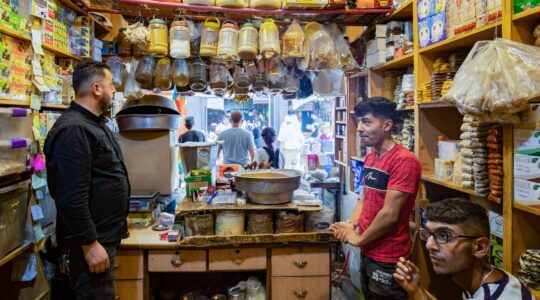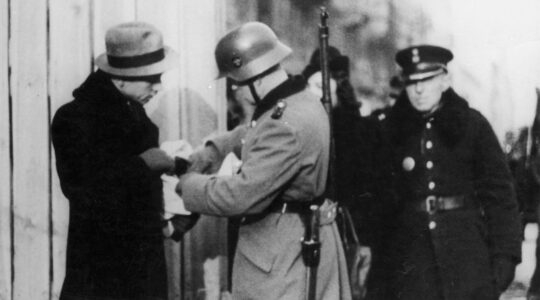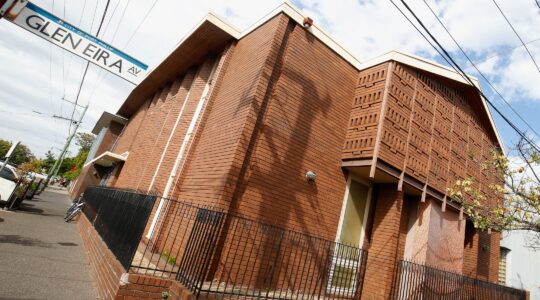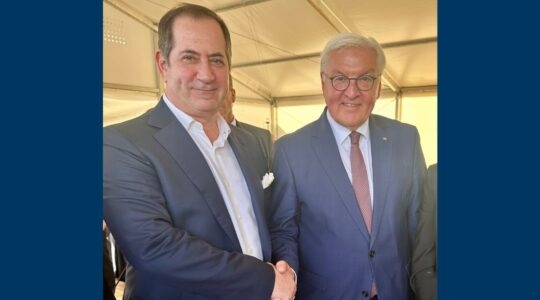PRAGUE (JTA) — A large Jewish museum set to open in the Czech Republic in October will be a far cry from any Jewish museum in Europe.
Instead of one building or a complex of exhibition halls in one city, it will be a nationwide museum comprising 10 linked thematic exhibitions in 10 restored synagogue buildings located in as many different towns and cities.
Called 10 Stars, the project is being coordinated by the Czech Federation of Jewish Communities, which owns the buildings, with the bulk of the funding coming from a $14 million grant from the European Union. About 15 percent of the financing is being provided by the Czech Culture Ministry.
“It’s actually one museum scattered around the country,” said Tomas Kraus, the executive director of the federation.
“The exhibition in each site will be linked to one certain phenomenon in Jewish history, culture, religion, traditions,” he said. “The idea is that if you visit one of the sites, even by chance, you will realize that there are nine other parts of the exhibition, so you will want to visit them, too.”
To encourage this, 10 Stars will issue a “passport” that can be stamped each time a person visits one of the synagogues in the network. When all 10 stamps are filled in, the passport can be redeemed for a prize.
“We don’t know what that will be yet, though,” said 10 Stars project coordinator Jan Kindermann.
Following the fall of communism in 1989, the rescue and recovery of neglected synagogues and other Jewish heritage sites became a potent symbol of the revival of Jewish life, memory and culture in Eastern and Central Europe. This has been particularly true in the Czech Republic, where some 65 synagogues have been restored since 1989. Most of them are now used for cultural purposes, including several Jewish museums.
Under development for six years, the 10 Stars project is the country’s most ambitious Jewish heritage project, linking 10 widely scattered sites into a coordinated whole.
The idea of creating one museum spread across numerous sites sets 10 Stars apart from the dozens of other Jewish museums that have opened in European countries over the past two decades. They range from small community exhibits to mega projects such as the Russian-Jewish Museum of Tolerance in Moscow that opened in November and the multimillion-dollar Museum of the History of Polish Jews in Warsaw that is slated to open in the fall.
“It is a cross-regional ‘net’ project,” said Kraus. “There is a uniqueness that ties it together, even though every region is different and every building is different.”
10 Stars is a national adaptation of the model of the Jewish Museum in Prague, whose collections are displayed in themed exhibitions housed in several historic synagogues in the capital’s old Jewish quarter. With more than 500,000 annual visitors, it is the most frequented museum in the country.
Expanding that approach to synagogues throughout the country, the 10 Stars plan calls for complex preservation and restoration work on some synagogues and much-needed maintenance on others, including several that already have been restored. Thematic exhibits, largely based on photographs and text panels, will include Jewish education, Jewish life and practice, anti-Semitism, synagogue architecture in the Czech Republic, sources of Judaism, Jewish writers, Jewish industrialists and inventors, and the rabbinical world.
“Each main exhibit will focus on that theme, but there will also be a section that gives the Jewish history of the town,” said Kindermann. “There will also be space for temporary exhibitions and events like concerts and workshops. We also will be having small traveling panel exhibitions on each theme that can be installed in the other places in the network.”
The aim is to provide an educational resource for schools as well as to engage tourists and other visitors. But Kveta Svobodova, the program and exhibitions director, told JTA that the educational program is still under development.
“I think the real importance of these places is for local people to use as educational resources to break stereotypes,” said Martin Smok, a Prague-based consultant for the Shoah Foundation Institute for Visual History and Education at the University of Southern California. “I am aware that they are rescuing buildings, but I do hope that adequate attention will be paid to the content, the programming and the professionalism of the exhibits.”
A few of the themes will be linked specifically to a particular site. The town of Polna, for example, between Prague and Brno, was infamous as the site of a blood libel case in 1899. The 10 Stars exhibition there, to be housed in the restored 17th century synagogue, will focus on anti-Semitism and be a revamped version of an older exhibition in place since 2000.
Jicin, northeast of Prague, was the birthplace of the caustic critic and writer Karl Kraus, who was born a Jew but converted to Catholicism as a young man. The former Jewish school there, across the street from the restored synagogue, will house an exhibition devoted to Jewish writers, playwrights and critics of the 19th and early 20th centuries, as well as a small conference facility.
The 17th century synagogue in Boskovice, which had been restored a dozen years ago, stands at the heart of one of the more extensive and best-preserved old Jewish ghetto areas in central Europe and will house an exhibit on Jewish quarters and ghettos in Czech lands.
And in Plzen, the only 10 Stars site that is home to an active Jewish community, the permanent exhibit to be installed in the restored Old Synagogue will deal with Jewish life and practice, and will include video interviews with local Jews and Holocaust survivors.
JTA has documented Jewish history in real-time for over a century. Keep our journalism strong by joining us in supporting independent, award-winning reporting.





